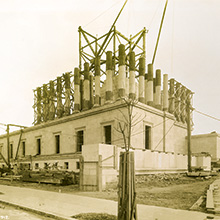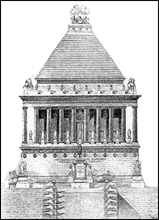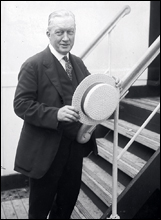 History of the Temple
History of the Temple
 During the Supreme Council’s session in October 1909, a resolution was passed to enlarge or extend the existing House of the Temple in Washington, D.C., or to erect a new one. This unanimously enacted resolution gave Grand Commander James D. Richardson “full power to do any and all things necessary and proper in connection herewith (that is the building etc.,) including the purchase of the necessary real estate and the erection of a suitable building, furnishing the same, etc.” (1911 Transactions, p. 115).
During the Supreme Council’s session in October 1909, a resolution was passed to enlarge or extend the existing House of the Temple in Washington, D.C., or to erect a new one. This unanimously enacted resolution gave Grand Commander James D. Richardson “full power to do any and all things necessary and proper in connection herewith (that is the building etc.,) including the purchase of the necessary real estate and the erection of a suitable building, furnishing the same, etc.” (1911 Transactions, p. 115).
Grand Commander Richardson was deeply committed to building a new Temple so magnificent that it would be revered by all Scottish Rite Masons worldwide. His dedication to this endeavor is best illustrated by his own words:
This task or duty was not self-imposed or invited by me, but was put upon me by your vote.… In the attempt to execute it I have felt that we were building, not for today, or the next year, or the year after, but, most probably, for fifty years and that, as nothing is too good for our Council or for Scottish Rite Masonry, the Temple should be built right, so that it could, and would be pointed to, by our brethren here and elsewhere, as the pride of the Mother Council of the Rite and all Scottish Rite Masons in the world. We are building a Temple, a permanent home, in the Great Capital of the Greatest nation of the Earth. I would prefer to be criticized for building a Temple, considered by some, too fine and costly, rather than for a cheap or mediocre building, surrounded as it will be, by the beautiful structures of our Capital. Better not build at all, than only half way build, while we are engaged in the laudable enterprise. (1911 Transactions, p. 125). — Grand Commander James D. Richardson (1911)
 After reviewing numerous submissions by various architects, Richardson finally saw a design that met his vision of a majestic edifice to be the symbol of the Scottish Rite Mother Council of the World. Pope’s vision for the new Temple was based on one of the Seven Wonders of the Ancient World, the Tomb of Mausolus at Halicarnassus, Turkey.
After reviewing numerous submissions by various architects, Richardson finally saw a design that met his vision of a majestic edifice to be the symbol of the Scottish Rite Mother Council of the World. Pope’s vision for the new Temple was based on one of the Seven Wonders of the Ancient World, the Tomb of Mausolus at Halicarnassus, Turkey.
Grand Commander Richardson accepted the basic design, and on April 16, 1910, he and Pope signed the contract to employ Pope to “complete the plans and supervise the erection of the new House of the Temple. Richardson instructed Pope to make “the new Temple as magnificent as art and money can make it” (Architect of Empire, p. 123).
The Grand Commander set May 31, 1911, as the day for the ground-breaking for the new House of the Temple—the 110th anniversary of the founding of the Supreme Council in Charleston, South Carolina. At 9:00 am on the 31st, Richardson turned “the first spade of earth in the building of the new Temple” (1911 Transactions, p. 124). In attendance were several members of the Supreme Council and numerous photographers and newspaper correspondents to record the historic event.
As the builders went about the work of excavating for the basement and foundations, Richardson arranged for an event to celebrate laying of the cornerstone on October 18, 1911.Pope took to heart Richardson’s commitment to create “the most beautiful Masonic building in the world.” (Architect of Empire, p. 126). Pope set out in earnest to create an elaborate masterpiece that would serve the Masonic ideal Richardson inspired.
The new House of the Temple, located at 1733 Sixteenth Street, NW in the District of Columbia was completed in October 1915. It is unfortunate that Grand Commander Richardson passed away on July 24, 1914, before he could see his vision fully completed. The honor of conducting the dedication ceremony and officially opening the House of the Temple went to the new Grand Commander, George F. Moore.
One hundred years later, the House of the Temple remains an emblem of greatness, but it needs our attention now. To restore and maintain its grandeur, we must attend to the hard work of renovating this historic building. Over the next five years, extensive work must be done, work that can wait no longer. Restoring a one-hundred-year-old historical building requires a great deal of expertise and care. We need your support to accomplish this daunting task.

Steven McLeod Bedford, author of John Russell Pope: Architect of Empire, maintains that the Temple of the Scottish Rite would be the subject of constant praise for the next twenty years. The January 1916 issue of the London Architectural Review noted that “this monumental composition may surely be said to have reached the high-water mark of achievement in that newer interpretation of the Classic style with which modern American architecture is closely identified.”
Pope is well known for his other works in the District of Columbia, including the National Gallery of Art, National Archives and the Jefferson Memorial. The House of the Temple was his first major commission in the District of Columbia. He was only 36 years old at the time he signed his contract for the building.
In 1917, Pope’s peers awarded him the Gold Medal of the Architectural League of New York for the design. French Architect Jacques Greber in his L’Architecture aux Etatis-Unis of 1920 described it as “a monument of remarkable sumptuousness …the ensemble is an admirable study of antique architecture stamped with a powerful dignity.”
References
- Transactions of the Supreme Council of the 33d Degree for the Southern Jurisdiction of the United States of America. Washington: Supreme Council, 33°, 1911.
- Bedford, Steven McLeod. John Russell Pope: Architect of Empire. New York: , Rizzoli International, 1998.
- Carter, James D. History of the Supreme Council, 33° Ancient and Accepted Scottish Rite of Freemasonry Southern Jurisdiction, U.S.A. 1891–1921. Washington: Supreme Council, 33°, 1967.
- The Architectural Review, Volume IV, Number 1. London, 1916
- Greber, Jacques. L’Architecture aux Etatis-Unis of 1920






